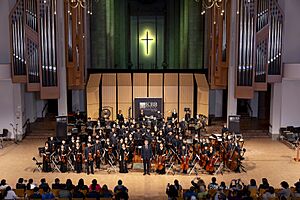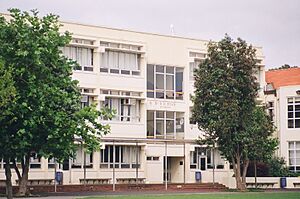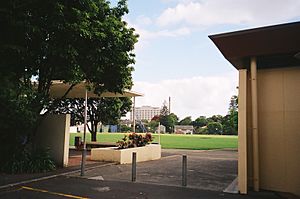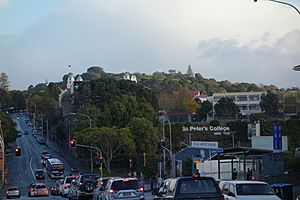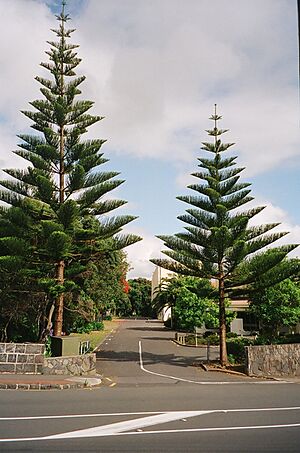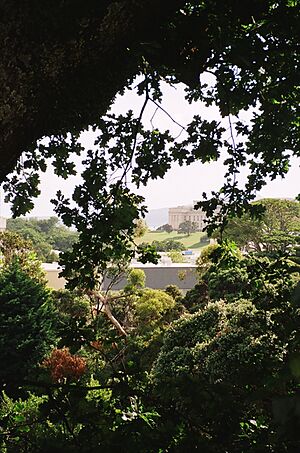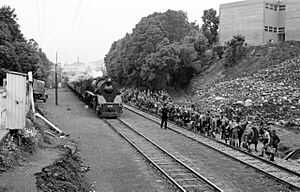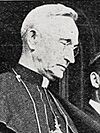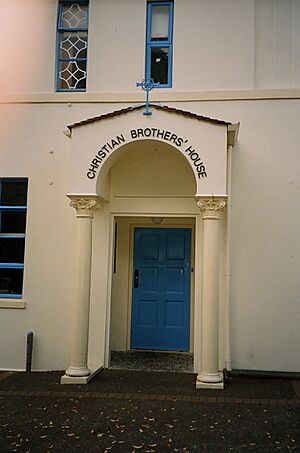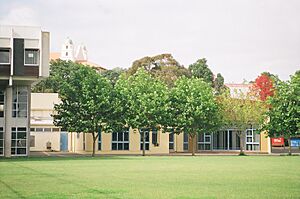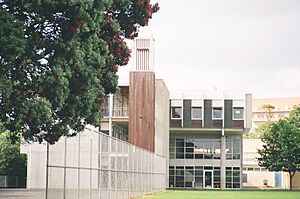St Peter's College, Auckland facts for kids
Quick facts for kids St Peter's CollegeMāori: Te Kura Teitei o Hāto Petera
|
|
|---|---|
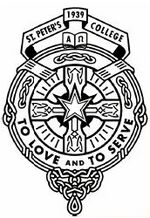 |
|
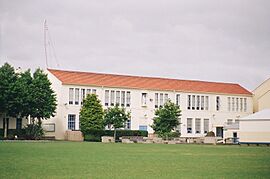
St Peter's College (Bro. O'Driscoll Building, 2009) (constructed 1939)
|
|
| Address | |
|
23 Mountain Road, Grafton
, 1023
New Zealand
|
|
| Coordinates | 36°52′3″S 174°46′8″E / 36.86750°S 174.76889°E |
| Information | |
| Type | State Integrated, boys secondary, years 7–13 |
| Motto | ‘To Love and to Serve’ |
| Religious affiliation(s) | Catholic |
| Patron saint(s) | Saint Peter |
| Established | 1939; 86 years ago (original schools founded 1841 and 1857) |
| Ministry of Education Institution no. | 62 |
| Chairman | Craig Mulholland |
| Headmaster | James Bentley |
| Years offered | 7–13 |
| Gender | Boys |
| School roll | 1,292 (February 2024) |
| Socio-economic decile | 8P |
St Peter's College (Māori: Te Kura Teitei o Hāto Petera) is a Catholic secondary school for boys in Auckland, New Zealand. It follows the traditions of Edmund Ignatius Rice, who founded the Christian Brothers, and is named after St Peter. The school is located in the central Auckland area of Grafton. With over 1300 students, it is one of the largest Catholic schools in New Zealand. St Peter's College started in 1939, continuing the legacy of Auckland's very first school (Mr Powell's School, from 1841) and an earlier St Peter's School (from 1857).
The land for St Peter's College was given by the Outhwaite family, who owned the Mountain Road area since around 1841. For 70 years, the Christian Brothers taught at the college. St Peter's is the oldest Catholic boys' school in Auckland that is still on its original site. For almost 50 years, the school had its own railway station, first called "St Peter's College station". In 1982, the school became part of the state system, like many other Catholic schools in New Zealand.
Contents
- About St Peter's College
- School History
- Early Schools in Auckland
- Starting St Peter's College
- Building and Opening the School
- Starting School in 1939
- New Buildings and Growth
- Sports at St Peter's
- The Cage and the Motorway
- The School's Own Railway Station
- School Chapels
- James Liston's Role
- The Christian Brothers' Legacy
- St Peter's College After 1989
- Headmasters of St Peter's College
- Famous Former Students and Staff
- See also
About St Peter's College
Student Numbers and Learning
St Peter's College offers secondary education to Catholic boys from all over Auckland. The school does not have a "zoning" system, which means boys don't have to live in a certain area to apply. However, many boys want to join, so the school is very selective. Catholic boys are given priority. In 2024, boys from 55 different primary schools joined Year 7 at St Peter's. The school also looks for students who are good at sports like rugby, have musical talent, show strong academic skills, and come from supportive homes.
In 2024, the students came from many different backgrounds:
- European/Pākehā: 47.7%
- Māori: 12.5%
- Polynesian: 15.7% (including Samoan and Tongan)
- Asian: 18.4% (including Chinese, Korean, Indian and Filipino)
- Other: 5.7%
The school has about 124 staff members, including teachers, support staff, and grounds staff.
For students in Years 11-13, the school offers two main assessment systems:
- National Certificate of Educational Achievement (NCEA)
- Cambridge International Examinations (CIE)
In 2023, 95.0% of students who finished their courses at St Peter's College qualified for University Entrance. This was much higher than the national average for all secondary schools (47%). Most students from St Peter's College, including Pasifika and Māori students, go on to study at university.
Music, Culture, and Sports
St Peter's College believes music education is very important. All Year 7 and 8 students learn to play a musical instrument. There are many music groups for both younger and older students. St Peter's also works with its sister school, Baradene College of the Sacred Heart, on groups like a Symphony Orchestra, Jazz Band, and Choir. The school has a strong tradition of choirs, with both senior and junior groups.
The school's diverse student body has helped it succeed in the ASB Polyfest, a competition for cultural performances by schools. St Peter's has won the Samoan section multiple times (2007, 2008, 2009, 2010, 2011, 2014, 2015, and 2021). The Tongan group Kailao also won in 2021. In 2020, the Kapa haka group reached Division One at Polyfest for the first time.
For at least 25 years, St Peter's has put on an annual musical production with its sister school, Marist College. In 2024, they performed “Priscilla, Queen of The Desert,” and in 2025, "Sister Act."
St Peter's College offers a wide range of sports, including:
- Archery
- Athletics
- Badminton
- Basketball
- Chess
- Cricket
- Cycling
- Football
- Golf
- Hockey
- Rowing (started in 1941)
- Rugby union
- Softball
- Swimming
- Table tennis
- Tennis
- Volleyball
- Water polo
In 2022, about 1000 students played Winter sports in over 60 teams.
School Spirit and Values
Monsignor Paul Farmer, who was a student at St Peter's from 1960 to 1965 and has been the school chaplain at different times, including in 2021, talked about how the school has changed. He said that in 2021, students were much easier to manage and were treated with more respect.
Farmer explained that in his student days, there was a lot of uniformity. "It didn't matter who you were or where you came from, whether you were intelligent or dumb, one shirt fitted everybody. It was very much a macho male culture. It was a shouting and noisy culture.” He said that this has changed. “I think there is much more respect for the individual boy, for the differences in character, for the different places in which people learn. And the staff, I think, are much more respectful overall of the students than they were previously. I think that is why the students are so much more able to be managed and to be respectful. It is a much more respectful place."
The college takes its special Catholic character seriously. Students, Christian Brothers, and others, including students from sister school St Mary's College, often explore what this special character means.
The school also remembers its Edmund Rice (Christian Brothers) history. In 1988, Brother Prendergast, a headmaster, described what makes a Christian Brothers school special:
- Encouraging students to do well academically.
- Having a strong religious focus.
- Encouraging devotion to the Virgin Mary.
- Caring for each student in the school community.
- Having a special concern for those who are poor.
He also noted that Christian Brothers' schools around the world share a similar purpose and spirit. Other Edmund Rice schools in New Zealand include Liston College, Auckland; Trinity Catholic College, Dunedin; St Kevin's College, Oamaru; and St Thomas of Canterbury College, Christchurch.
Students from Year 7 to Year 12 at St Peter's must complete service work, which is unpaid work for people who are not relatives. Year 13 students choose a special project to work on.
School Houses
St Peter's College uses a house system to organize students by year level. Each year group has six house classes. These classes are used for attendance, student support, competitions, and many daily activities. Each house has student leaders and staff leaders.
The houses, their colors, and the people they are named after are:
- Bodkin – red – Dominic Fursey Bodkin
- Lynch – yellow – John Barnabas Lynch
- Nolan – blue – Patrick Joseph Nolan
- O'Driscoll – grey – Francis Pius O'Driscoll
- Rice – black – Edmund Ignatius Rice
- Treacy – green – Patrick Ambrose Treacy
Brothers Fursey Bodkin, Barnabas Lynch, Joseph Nolan, and their leader, Patrick Ambrose Treacy, were Christian Brothers who came from Ireland to Australia in 1868 to start their religious group there. In 1876, Brother Bodkin led the first Christian Brothers community in New Zealand, in Dunedin. Bodkin, Lynch, Nolan, and Treacy Houses were created in the 1940s. O'Driscoll and Rice Houses were added in 2011. Edmund Ignatius Rice founded the Christian Brothers, and Brother O'Driscoll was the first headmaster of St Peter's College.
School History
Early Schools in Auckland
Mr Powell's School (1841)
Auckland's very first school was a Catholic boys' school that opened on September 27, 1841. It was started by Catholic laymen (people who are not priests) after Bishop Pompallier visited. The teacher was Edmund Powell, and classes were first held in his home. This school was open for a short time.
St Peter's School (1857–1885)
In 1857, St Peter's School was founded by a group of laymen and Father O'Hara. It was Auckland's first Catholic secondary school for boys. Bishop Pompallier listed it as a school that taught Greek, Latin, French, Italian, German, Geometry, Arithmetic, Geography, and English Grammar. The school had a board of governors, including a Member of Parliament, Patrick Dignan. Classes began in rented rooms, and later a brick school building was built on land donated by John Logan Campbell. The first teacher was Richard O'Sullivan. Famous students included John Sheehan and Joseph Tole.
Bishop Pompallier visited the school every year. In 1864, students gave speeches to him. St Peter's School also played a big part in St Patrick's Day celebrations. In 1865, after Mass, the boys played sports, including a cricket match against girls from St Francis de Sales School, which the girls won!
In the 1870s and 1880s, Mr B Hammill and Mr Peter Leonard were well-known teachers. In 1874, about 70 students attended the school. St Peter's School continued, mostly as a primary school, until the Marist Brothers started their own school on the site in 1885.
Starting St Peter's College
In 1929, James Liston, the new Catholic Bishop of Auckland, invited the Christian Brothers to start a school. He had been a student at a Christian Brothers school himself. This idea faced some challenges from the Marist Brothers, who already had a school and worried about losing students. However, Bishop Liston was determined, and the Christian Brothers agreed to staff the new school.
The land on Mountain Road was cleared in 1931, but financial problems caused delays. After some discussions, it was decided that Bishop Liston could invite the Christian Brothers, and the Marist Brothers accepted this decision.
Building and Opening the School
The school was built on land given to the church by the Outhwaite family, a pioneering family in Auckland. Isa Outhwaite, the last member of that family, left the land and some money for the school's construction in her will. The school was named St Peter's College to honor the earlier St Peter's School and the very first Catholic school in New Zealand, which opened in 1840.
The Christian Brothers arrived in Auckland from Australia and the South Island for the 1939 school year. They stayed with a local priest until their own residence was ready. Many workers, including those from a government relief scheme during the Great Depression, helped prepare the school grounds. They worked for three years, finishing in November 1941. They moved tons of soil to create the playing fields.
The school officially opened on Sunday, January 29, 1939. Bishop Liston, along with important guests like the Attorney-General and the Mayor of Auckland, attended the ceremony. It was a rainy day, and Bishop Liston read his speech under an umbrella held by the first headmaster, Brother F.P. O'Driscoll.
Bishop Liston welcomed the Christian Brothers, saying they would bring their traditions of teaching since 1802. He believed they would encourage boys to work hard and prepare them for life's challenges with courage. He also shared his personal gratitude, saying he owed much to the Christian Brothers who taught him in Dunedin.
The first school buildings, opened in 1939, included a two-story classroom block (now the Bro P. O'Driscoll Building) and the Brothers' residence. These were designed by William Henry Gummer, a famous architect. The buildings were fully finished in 1944. In 1955, a statue of the Blessed Virgin Mary was placed on the Bro P O'Driscoll Building.
Starting School in 1939
On Monday, February 6, 1939, St Peter's College welcomed its first 183 students, aged 11 to 14. Five Christian Brothers were the first teachers. The first Year 10 class had only fourteen students from different schools, and they had studied different subjects. The Brothers decided to restart the Year 10 curriculum in May, covering two years of work in just two terms. This meant cutting recreation time and having school on Saturday mornings for science experiments. Many students moved to Year 9. By the end of the year, only four students remained in the senior class, and all four passed their exams. The first top student (Dux) of the college was Des Rosser in 1940, followed by his twin brother John in 1941. The Rosser Cup, awarded each year to the Dux, is named after them.
New Buildings and Growth
Over the next few years, the school grounds continued to be developed. Reeves Road became the school's entrance, and stone walls were built. Many trees were planted, including native Pūriri and Pōhutukawa trees. A huge stone retaining wall was also built, which the first students watched being constructed with wonder.
After World War II, the college chapel opened in 1953. Prefabricated classrooms were added, and an old bungalow was turned into a library.
By 1961, St Peter's had the largest number of students of any Catholic school in New Zealand, with 834 pupils. This meant more buildings were needed. In the 1960s, the Brothers' residence was expanded, and a new science block was built. This building is now called the Brother J. B. Lynch Science Laboratories. A large three-story classroom block (now the Brother B E Ryan Building) and an assembly hall opened in the early 1970s.
Sports at St Peter's
St Peter's College has a strong and successful history in sports. This began early, with the college joining the secondary schools' rugby union in 1939. In 1941, they won the seventh-grade rugby competition. The first annual swimming championships were held in 1941. Softball also started early, with students playing in competitions in 1945. St Peter's College won the national Secondary School's Softball Championship in 1981, 1990, 1999, 2000, 2002, and 2003. They also won the Auckland Softball Premiership many times.
In the 1960s, there was a strong expectation for boys to play rugby. John Tamihere, a student in the 1970s, remembered the Christian Brothers being very keen on rugby. He said they would look for tall boys to play in the lineout. Tamihere played for the college's First XV (the top rugby team) in 1975 and 1976, even though he preferred rugby league. He said the team was "always competitive." St Peter's has traditional rugby rivalries with schools like Liston College, De La Salle College, and Auckland Grammar School. An annual rugby game between Auckland Grammar and St Peter's, called The Battle of the Bridge, is played for a special cup.
Some of the college's rugby highlights include winning the New Zealand Secondary School's Top Four Championship and the Auckland Secondary Schools Premiership in 1987 and 1988. The college won the Auckland Championship and the New Zealand First XV Knock out competition undefeated in 2000. Most recently, St Peter's won the Auckland Secondary Schools Premiership and the National First XV Championship final in 2018. The college has won the Moascar Cup (a national rugby honor) three times: in 1977, 2000, and 2018.
Although St Peter's College did not have rugby league teams, many students played Soccer. The top soccer team competed in the Auckland Premier grade and placed third at the NZ Football Championships in 2019 and second in 2023. Basketball and hockey teams also compete in the Auckland Premier Grade.
The Cage and the Motorway
In 1959, Archbishop Liston bought 2.5 acres of land on Mountain Road, across from the school. This land, which used to be part of a brewery, was bought at a special price for St Peter's College. Parents of the school raised the money through fairs and raffles. Students even helped by picking up stones and glass from the field. This land became a rugby field, first called "the Far Field" or "the New Field," and now known as "the Cage." It has a sports pavilion named the Brother P. C. Ryan Sports Pavilion, after the headmaster who helped buy the land. In 2012, the Cage was updated with an Astro turf field, so rugby and soccer can be played in all weather.
The nearby Auckland Grammar School was also interested in this land, but it was too expensive for them. However, the headmaster of Auckland Grammar, Henry Cooper, still attended the opening of St Peter's new pavilion and field in 1960 and congratulated the school.
The Auckland Southern Motorway was planned to go through Auckland Grammar's main rugby field. Although St Peter's was less affected, Bishop Liston supported Auckland Grammar in opposing the motorway. Both schools have had to live with the motorway next to them since 1965.
The School's Own Railway Station
For almost 50 years, St Peter's College had its own railway station. It was created in 1964 because many students from St Peter's College and Auckland Grammar School took the train. Before the station, they had to get off at Mt Eden Station and walk to school, crossing busy roads and railway lines. The new station, first called St Peter's College station, meant "school trains" could stop right near the school. Later, it became a full stop for all passenger trains and was known as Boston Road Station.
Today, up to a third of the school's students (about 400) travel to college by train, using the Grafton station (which replaced Boston Road Station). Seeing St Peter's boys on Auckland's suburban trains is a common sight.
School Chapels
1939 Chapel
When the school opened in 1939, the Christian Brothers had a small chapel upstairs in their residence. It was furnished with oak and walnut wood, and an altar was donated by a former student of the Christian Brothers.
1953 Chapel
On November 14, 1953, a larger chapel was opened by Archbishop Liston. This chapel was built thanks to the efforts of the school chaplain, Father Reginald Delargey, and funds raised by parents, friends, former students, and the students themselves. The chapel was located between the Brothers' House and the main school building. It was a rectangular space with pews for students and chairs for the Brothers. A crucifix and a large altar were at one end. There was also a shrine to Our Lady of Perpetual Succour. This chapel was a central point for the school, and students often visited the Blessed Sacrament before and after school. This chapel was later removed to make way for new buildings in 2001.
2001 Chapel
A temporary chapel was used from 2001 until the permanent school chapel was built.
2020 Chapel
"The Chapel of St Peter" opened on March 13, 2020, in the upper yard of the school. It cost about $3 million, raised by the school community over more than ten years. The chapel's design includes an inverted cross motif, similar to the large illuminated cross at the college entrance. When sunlight shines through the skylight, an inverted cross appears on the floor. The headmaster, Mr James Bentley, said the building shows what the college stands for and is a place of worship for the school and the wider community. The first Mass was celebrated in the new chapel on March 15, 2020.
The chapel is next to the school's top yard and can be seen from Khyber Pass Road. It has two smaller, quiet chapels inside: one for the Blessed Sacrament and another for Reconciliation. The design aims to make students feel they are entering a sacred space.
Mass is celebrated in the chapel every Friday at lunchtime, and all students are invited. The chapel is open all day for prayer and guidance. Larger school religious events usually take place at city churches like St Michael's Church or St Patrick's Cathedral.
James Liston's Role
Archbishop Liston, who founded the college in 1939, attended all the school prize-giving ceremonies until he retired in 1970. The headmaster in 1970, Brother B E Ryan, said that St Peter's College might not have existed without Liston's decision to establish it.
Liston often spoke about how grateful he was to the Christian Brothers' School in Dunedin, where he had been a student. There's a story that when a large Christian Brothers emblem was being made above the main entrance of the original school building in 1938 or 1939, Bishop Liston ordered work to stop. He said the school was "his" and didn't belong to the Christian Brothers. The emblem was finally completed in 2014. The college is owned by the Bishop of Auckland.
When Liston passed away in 1976, the college formed a guard of honor for his funeral procession. The school later adopted a new motto, "To Love and to Serve," which was the English version of Liston's personal motto.
The Christian Brothers' Legacy
The Christian Brothers taught at St Peter's College from its opening in 1939 until 2007. Their numbers gradually decreased from the 1970s. By 1994, only one Christian Brother, Brother Paul Robertson, was teaching full-time. He was the associate principal until July 2007.
When St Peter's College became part of the state education system, the Christian Brothers community became separate from the school's management. The Christian Brothers moved out of the college building in 1992 to a new community house nearby. Brother V. N. Cusack worked in the school tuckshop until 1997, arriving early every day to heat pies. Mr Peter Watt, a former student and Christian Brother, taught at the college for many years, retiring in 2016.
Monsignor Paul Farmer, the college chaplain, whose father was one of the first students in 1939, praised the Christian Brothers' work. He said: "The Brothers, I think, created an extraordinary spirit - they laid the foundation for the school. They were good men, practical men, and very generous men with their talents and their lives. They ran the place on the smell of an oily rag... They put their hearts and soul into the place. Everything was done by them - a broken window was fixed, the lawns were mowed, everything."
St Peter's College After 1989
Since 1989, the school has been led by headmasters who are not Christian Brothers. During this time, the number of students grew significantly, from 669 in 1989 to 1,344 in 2015, and has stayed around that level. In the 1990s, the Brother J. B. Lynch Science Laboratories were renovated, and a new sports pavilion, the Brother P. C Ryan sports pavilion, was built. The Brother W. R. Smith Music and Drama Suite was also constructed. Brother Smith, the third headmaster, started the first school orchestra.
The Brother L. H. Wilkes Technology Block opened in 2001 and won architectural awards. A dedicated building for the intermediate school (Years 7 and 8), called the "Middle School" and named after Brother V.A. Sullivan, was occupied in 2003. The St Peter's College Sports Complex, built on the old netball courts, opened in 2010 and also won an architecture award. In 2015, a 12-classroom block called the "Outhwaite Building" was completed, honoring Isa Outhwaite, who donated the school site. This building was placed carefully to protect the "Sam Hunt" Pōhutukawa tree, where the poet Sam Hunt used to recite poems as a student.
St Peter's continues to follow the goals of Blessed Edmund Rice, encouraging students to serve the community. Students participate in programs like Edmund Rice Camps and work towards social justice. All students must complete service work. The school also supports Christian Brothers' missions in Polynesia, especially Nukutere College in Rarotonga, and organizes trips to India for older students.
The school has high academic standards and has won many awards in music and sports. Its diverse student body has also led to success in cultural activities like the ASB Polyfest.
Kieran Fouhy was the first headmaster who was not a Christian Brother, leading the school for 27 years from 1989 to 2015. He received an award for his services to education in 2016. James Bentley became the tenth headmaster in 2016. Under his leadership, the new chapel was completed, and "Watty's Nets" were opened for cricket practice. The Brother J B Lynch Science Laboratories were also renovated and reopened in 2024.
Headmasters of St Peter's College
Here are the headmasters who have led St Peter's College:
| Ordinal | Officeholder | Term start | Term end | Time in office | Notes |
|---|---|---|---|---|---|
| 1 | Bro. Francis Pius O'Driscoll, c.f.c. | 1939 | 1944 | 6 years | |
| 2 | Bro. James Alexis Morris, c.f.c. | 1945 | 1947 | 3 years | |
| 3 | Bro. W. R. Smith, c.f.c. | 1948 | 1953 | 6 years | |
| 4 | Bro. K. V. Watson, c.f.c. | 1954 | 1956 | 3 years | |
| 5 | Bro. Patrick Celestine Ryan, c.f.c. | 1957 | 1965 | 9 years | |
| 6 | Bro. Benjamin Everard Ryan, c.f.c. | 1966 | 1974 | 9 years | |
| 7 | Bro. Noel Cuthbert Doherty, c.f.c. | 1975 | 1979 | 5 years | |
| 8 | Bro. John Paschal Prendergast, c.f.c. | 1980 | 1988 | 9 years | First old boy headmaster |
| 9 | Kieran Francis Fouhy MNZM | 1989 | 2015 | 27 years | First non-Christian Brother headmaster. Awarded MNZM for services to education in 2016. |
| 10 | James Bentley | 2016 | incumbent |
Famous Former Students and Staff
You can find lists of notable people who studied or worked at St Peter's College here:
- List of people educated at St Peter's College, Auckland
- List of former staff of St Peter's College, Auckland
- Congregation of Christian Brothers in New Zealand
Some well-known former students include:
- Mark Williams – an academic and writer
- Sam Hunt – a poet
- David McGill – a writer
- John Tamihere – a politician
- Frank Nobilo – a golfer
- Felix Donnelly – a priest
- Colin Jillings – a horse trainer
- Cyril Eastlake – a footballer
- Jonathan Temm – a lawyer
See also
 In Spanish: St Peter's College para niños
In Spanish: St Peter's College para niños
- List of schools in New Zealand
- Education in New Zealand
- Catholic Church in New Zealand


